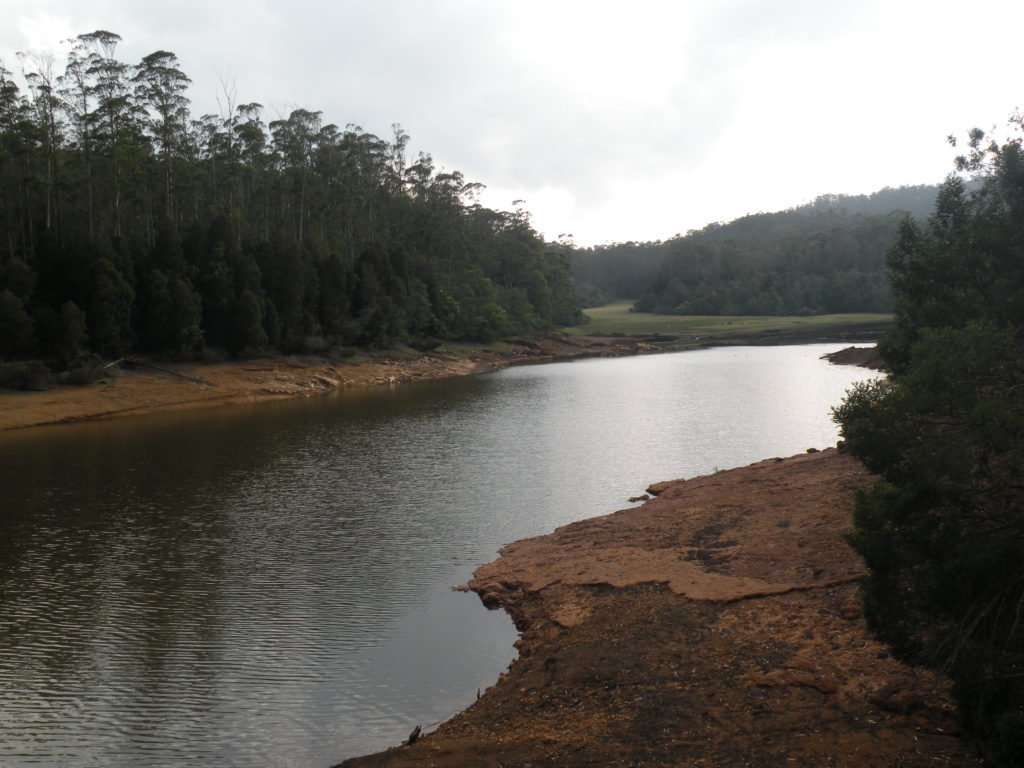 The Nilgiris, Blue Mountains of South India, is located at the junction of the Eastern Ghats and the Western Ghats, the two prominent mountain ranges that run almost parallel to the coastlines of Peninsular India.
The Nilgiris, Blue Mountains of South India, is located at the junction of the Eastern Ghats and the Western Ghats, the two prominent mountain ranges that run almost parallel to the coastlines of Peninsular India.
The high hills are a wonderful gift of Nature. Widespread forests and abundant water sources make the hills a fountainhead of the plains below. Water plays a crucial role in the lives of the people and animals, used as it is not only for drinking, but also serve as the upstream source to four river basins serving the states of Tamil Nadu, Karnataka and Kerala. Water as a natural resource plays a vital role in the ecology and economy of the district – be it in the large scale hydro power, the tea estates or in the forest dweller’s livelihood system. The region is also home to unique wetlands that are the source of sustenance of animals and human communities.
These rivers and wetlands are under threat today. Over the years these natural systems and watersheds have seen a lot of change in the Nilgiris. Building a series of hydro electric projects, tunneling the water to different areas for irrigation, building reservoirs, planting the upper areas with commercial pulpwood species and replacing natural grasslands with tea and marshes with vegetables has changed the district’s water regime. Besides affecting availability, the management of the resource has shifted from local communities and indigenous groups to the state. This has resulted in several community based systems to collapse and increased the dependence on a centralized body.
Land use changes have affected the original landscape of the entire hills district and are continuing even today. Faced with an alarming scenario, Keystone felt an urgent need to work on the aspects of water management, protection of resources and ensuing awareness amongst dependent communities. The process began with the Nilgiri Water Resources Project in year 2002 and is ongoing today. In between, we did a thorough sampling of water resources, did a survey of wetlands and work with indigenous people for the protection and management of water sources. The process continues and the need for more awareness on water management continues too.
Peoples Places and Water
The district is located over an elevation range of 1,000-2,636 m above sea level, comprising hilly peaks, plateau and lower plateau regions – most of the settlements are located in the latter two elevation ranges. The district is home to a number of indigenous communities and they include the Todas, Badagas, Kotas, Kasavas, Irulas, Kurumbas, Jenukurumbas, Mullu Kurumbas, Bettu Kurumbas, Kattunaickens, Paniyas, Mandadan Chettis and Wynaadan Chettis.
Water from the upper areas flows through diverse landscapes, bringing with it a complex interaction and dependence. This is probably the only district where so many aspects of natural resources are linked in such a tight space. Spatial-temporal blocks exist, where cultures converge like the Badagas-Todas-Kotas in the upper areas, the Irulas-Kurumbas (in the lower areas), the urban and migrant population in the middle elevations. Each of these communities has a unique approach to water systems. Traditional management and indigenous knowledge have been eroded to a significant extent. Government power generation projects have also manipulated water systems. Government water supply and maintenance through different mechanisms and devices, have made forays into traditional systems of management, all not necessarily beneficial.
Geology Landscape History
Geologically the Nilgiris belong to the Archean continental landmass of the Indian peninsula, composed of pre-Cambrian, mainly metamorphic rocks (gneisses, charnockites, and crystalline schist). Due to continental drift of the “Indian shield” which until late Jurassic times was a part of the ancient Gondwanaland – and coincident with the Himalayan orogenesis during the Cretaceous and Tertiary periods, geotectonic movements in the southern Deccan resulted in its fragmentation and in vertical dislocations along fault lines that are oriented in three main directions, viz. NNW-SSE, NE-SW and W-E, and that recur in the morphological boundaries as well as in the courses of many streams and rivers of the Nilgiris.
Thus, the triangular-shaped mountain block of the Nilgiris was formed by the phase-wise uplifting of a portion of the Deccan. This horst is almost entirely made up of more or less garnetiferous, acid hypersthenic charnockites (Holland 1900) with a general NE-SW to ENE-WSW strike of foliation (Eastern Ghats trend) and traversed by doleritic and quartzite dykes. It is slightly tilted towards the east – like the entire Deccan Plateau – and has a base size of roughly 2400 square kilometers, of which 40 % rises above 1800 meters in the central Nilgiris Plateau (which falls off steeply on all sides). It culminates in Dodabetta, or “big mountain” with 2636 m elevation above mean sea level.
It is the close spatial association of two contrasting morphological zones or relief types – the “mature” landforms of the elevated plateau and the “juvenile” Sigur, Pykara and other, minor rivers and streams, some of which have been dammed up during the past five decades.
While the first, uppermost level has been designated Dodabetta landforms, the second and third together represent the Ootacamund landforms (Pardhasarathi and Vaidyanathan 1974). All three can be identified as fossil, disintegrating relict landforms showing little, if any, morph dynamism of the kind responsible for their original formation and similar to that still active on the Mysore Plateau and on the Coimbatore Plains. Under present climatic conditions and due to upstream migration of nick points of stream profiles as well as the deforestation and tillage of large tracts of land, linear erosion generally prevails over denudation processes. This is increasingly so towards the edges of the plateau where numerous streams and rivers leave the upper Nilgiris in torrential rapids and picturesque cascades, with heights of up to 120 m, which emphasize the youthfulness of the Nilgiri mountain block as a morphological unit.
Drainage
The Nilgiris as a region can be divided into three strata of upper, middle and lower altitudinal zones. Each has a distinct vegetation and supports a variety of life forms and activities.
The Nilgiris district can be divided into four basins
1. Moyar Basin and its 24 rivers – draining mainly into the Bhavani reservoir as water supply for irrigation and drinking water in Tamil Nadu
2. Bhavani Basin and 26 rivers – draining again to the Bhavani reservoir along the district boundary and onwards again into the Tamil Nadu plains
Both the above basins finally feed into the Cauvery river basin.
3. Kabini basin and its five major rivers drain into Karnataka
4. Chaliyar basin and its eight rivers feed into Kerala
In spite of 1800-2000 mm annual average rainfall, the number of rainy days has reduced drastically. Erratic and unpredictable rains have changed the water budget and utilization pattern. Water enterprises, such as private water tankers have boomed in this district.
There is a crucial linkage between Shola patches (endemic montane forest-type which occur in this region) and water resources availability. Wherever Shola forests exist, existence of water source is assured.
Large Government Water Schemes of the TWAD Board basically tap springs and infiltration systems and not ground water resources. Wells are built in swamps and marshes so that percolation from springs around the well also take place. Feeder pipelines from other springs are also brought to the well. These springs are found in various altitudes. Local land use adjacent to these water bodies is critical in maintaining year round water flow. Several spring sources have dried up or the flow has drastically reduced due to land use changes or development works (revetment walls, road enlargement, check dams, etc.). Encroachments (very common) have destroyed water bodies as they have been converted for agriculture or tea thus blocking spring routes. In marshy environments, it is important to keep the passage of flow open – this is the key to wetland management, but unfortunately decision-makers perceive these areas as vacant land for further development works.
There is field data to show that rains are failing both as the annual average and the number of rainy days. This has severe negative consequences on this fragile hill district – the livelihood of people, the plantation & agriculture economies and the ecology.
Water Issues
Besides crop change over, regular harvest/logging increases soil erosion, large scale destruction of forests and marshes in the middle and lower zones for tea and vegetables respectively, also seems to have reduced rainfall dramatically in the district. (Reference: Project Appraisal Report of the Kundah & Lower Bhavani River Valley Project, 96-97 by Agricultural Engineering Department, Chennai). The change in land use from rain-fed agricultural crops to plantation crops requiring irrigation has also increased demand for irrigation, placing a widespread pressure on natural water sources. This change has caused severe erosion in the region, also affecting the low lying lands of indigenous communities.
Water Pollution
The increase in tea cultivation and commercial vegetable growing has also led to the increase in the use of chemical fertilisers, pesticides and weedicides. Some of these harmful chemicals have negatively affected the soil and water regime, percolating into the water sources. The water when used by indigenous communities for drinking purposes, has increased skin and water borne diseases.
Water Use and Management
There are a number of users of water in the Nilgiris. The Electricity Board, Plantation sector, Tourism industry, Agriculture & Horticulture sector are the main users. With a number of dams, weirs and tunnels – water is a managed resource in the hills. However, there are few points of water access for villages and especially indigenous communities. People have to resort to dug wells and springs for water. The water from the dams, both Pykara and Bhavani feed into the Metur Reservoir and is distributed in the Cauvery River Basin for irrigation. This has raised questions for local farmers and communities – as to why they do not have access to water from the district. eg. The village of Kallampalayam is located on the banks of the River Moyar, but does not have access to water for irrigation. Local measures need to be taken, to resolve this conflict.
Changing Culture of Water Use & Tradition: Nilgiris is a land of a myriad number of tribal groups and local ethnic communities. Some of them, like the Badagas, have a cohesive village governance and resource sharing system. Communities like the pastoral Todas, had traditional pasturages, based on the availability of water. Other hunter gatherer communities that were forest dwellers, moved their villages due to the invasion of wild animals. New sites were chosen depending on the water availability. Dug wells (Baavi) and protected springs (jo: ni), were treated with care and kept clean.
However, now these traditions are fast disappearing. People who could earlier manage their resource now look for government schemes and doled out benefits. There is also a change in their outlook from what was considered their own resource to that which belongs to the Government. There are no institutional systems in place to look after these government schemes, which sometimes lie in disuse or create conflict within the village.

